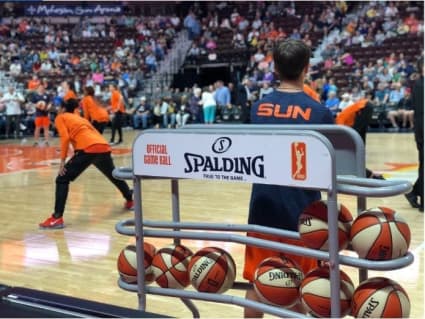The WNBA has been gaining steam the last few seasons, which is fantastic for the health of basketball and the future of the women’s side of the sport. A thriving, successful professional women’s league is excellent for the growth of the game and can inspire young girls to pick up a ball when they might have otherwise felt it wasn’t for them.
Still, the league is not drawing or profiting remotely close to the NBA or men’s college basketball, and there is plenty of room for growth. This is not an indictment on the WNBA or its future – it’s only been playing since 1997, and these things take tons of time – but it is the current reality. The W is in the best place it has ever been, but the number of relocated and dissolved teams since the WNBA began is almost as high as its current franchise count of 12, and player salaries have room to grow, to put it mildly.
One idea that has been offered to draw more eyeballs, and therefore dollars, to the league is lowering the WNBA rims from 10 feet, the worldwide standard for hoop height. One of the W’s most recognizable and influential faces, Elena Delle Donne, who expressed her support for the idea publicly starting in 2016.
“I think it would bring a whole different aspect to the game and bring viewership as well and show the athleticism of our women,” she said. “We do every single thing on that court that the men do, other than the dunking. And, obviously, there is a handful of athletes who can dunk. But when I look at other sports like volleyball, their net’s lower. Golf, their tees are closer. It goes on and on. Tennis, they play [fewer] sets. Why not lower our rim and let every single player in the league play above the rim like the NBA can?”
In the same year, Monique Currie sided with Delle Donne on moving WNBA rims in her personal blog.
“When you watch a men’s basketball game there is usually a dunk almost every other player and fans love it!” she wrote. “They want to see players defy gravity. Fans want to see athletes do the impossible, do something that they most likely cannot do themselves and that is dunk the ball.”
Another major figure in the college game, Geno Auriemma, has advocated for the idea before, too, citing the height differences between men and women as a major reason.
“What makes fans not want to watch women’s basketball is that some of the players can’t shoot and they miss layups and that forces the game to slow down,” he told the Hartford Courant in 2012. “How to help improve that? Lower the rim. Do you think the average fan knows that the net is lower in women’s volleyball than men’s volleyball? It’s about seven inches shorter so the women have the chance for the same kind of success at the net.”
He pushed for the cylinder to go down only 7.2 inches as an homage to Title IX, which was put in place in 1972.
But many others in the game have been vehemently opposed to the idea.
Some of the strongest language against the proposition came from Diana Taurasi in 2016, who seems to find the premise insulting.
“Might as well put us in skirts and back in the kitchen,” she said.
And she isn’t alone. Tina Charles explained in 2016 why she thought the WNBA rims should stay at 10 feet.
“I’m not in favor of lowering the rim. We just play differently,” Charles said. “What it takes for us in our process of winning, that’s just what we do with our skill development. I grew up playing on the same rim. I can say for myself and rest of the WNBA players, we grew up playing with the NBA basketball. I didn’t know there was a difference in the size of the ball until I started playing organized basketball. For me, everything is original for me, and that’s how I learned, so I would love for it to stay the same … I would take it as like a smack in the face. We are players, we are out there to perform and entertain, but at the same time, respect for our game and who are and what it took for us to get to where we are, leaving it where it is, is just fine.”
Not all opposition has focused on the personal aspect of the idea. Breanna Stewart questioned the importance of dunking in a segment of ESPN’s The Jump in 2018.
“I’ve been playing basketball on a 10-foot hoop my whole life, so to move it to nine-and-a-half is going to take a long time to get used to that,” Stewart explained. “Also, we’re only playing basketball to dunk? You just want to see me dunk on somebody?”
Some outsiders – not players or coaches in the sport – have reasonable arguments for and against lowering the WNBA rims, too. Kate Fagan wrote a column for ESPN in 2016 displaying her opposition, questioning if dunks are really what are drawing fans to the NBA or if a change like this could make people respect the WNBA and women’s game any more or less.
Earlier this year, B.G. Lemmon did an analysis on the effect the idea could have on the game and found a correlation between three-point attempts and dunks made, pointing out that though dunks may not be specifically what draws people to the NBA and men’s ball, their existence opens the floor for more explosive offense, and that could possibly be what attracts viewers, a counterargument to Fagan’s point.
What his post didn’t touch on, though, would be what it could do to young players and opening a gulf between girls and boys learning the game at a young age. Fagan doesn’t want yet another barrier between the genders, furthering the divide between men’s and women’s basketball and keeping the sport from simply being basketball, and it’s a common point made by those in favor of maintaining the 10-foot standard.
There doesn’t seem to be any serious consideration from the WNBA to change the height of its rims, and the NCAA doesn’t appear too interested, either. Fagan, and others, make a valid point that a decision to alter the basket’s height in the WNBA or NCAA would have to cause a ripple effect throughout the whole of women’s and girl’s basketball, and that a decision to do so should not be taken lightly. It would undoubtedly change the entire sport of basketball from top to bottom, for better or for worse, depending on who you ask.







